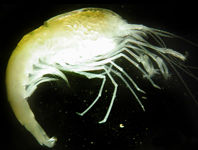Abstract
Until now, Honduriella Denmark & Evans has been known only from the holotype of its type species, Honduriella maxima Denmark & Evans. In recent surveys conducted in the Brazilian state of Amazonas, a second species of this genus was found. It is here described as Honduriella mcmurtryi Demite n. sp., based on morphological characteristics of adult females and males. Honduriella maxima is redescribed based on an examination of the holotype. In order to accommodate the new species, a modified characterisation of Honduriella is given.
References
Athias-Henriot, C. (1975) Nouvelle notes sur les Amblyseiini II. Le rélève organotaxique de la face dorsal adulte (Gamasides protoadeniques, Phytoseiidae). Acarologia, 17, 20–29.
Chant, D.A. & McMurtry, J.A. (2004) A review of the subfamily Amblyseiinae Muma (Acari: Phytoseiidae): Part III. The tribe Amblyseiini Wainstein, subtribe Amblyseiina n. subtribe. International Journal of Acarology, 30, 171–228.
https://doi.org/10.1080/01647950408684388Chant, D.A. & McMurtry, J.A. (2007) Illustrated Keys and Diagnoses for the Genera and Subgenera of the Phytoseiidae of the World (Acari: Mesostigmata). Indira Publishing House, West Bloomfield, 219 pp.
Chant, D.A. & Yoshida-Shaul, E. (1992) Adult idiosomal setal patterns in the family Phytoseiidae (Acari: Gamasina). International Journal of Acarology, 18, 177–193.
https://doi.org/10.1080/01647959208683949Climate-Data.org (2018) Available from: http://www.climate-data.org (accessed 30 March 2018)
Cruz, W.P. da, Krug, C., Vasconcelos, G.J.N. de & Moraes, G.J. de (2015) Diversity of mites associated with Raoiella indica (Acari: Prostigmata) on coconut palms in the central region of the Brazilian Amazonia, with emphasis on the predaceous Phytoseiidae (Acari: Mesostigmata). Systematic & Applied Acarology, 20, 875–886.
https://doi.org/10.11158/saa.20.8.4Demite, P.R., Cruz, W.P. da, McMurtry, J.A. & Moraes, G.J. de (2017b) Amazoniaseius imparisetosus n.sp., n.g.: an unusual new phytoseiid mite (Acari: Phytoseiidae) from the Amazon forest. Zootaxa, 4236 (2), 302–310.
https://doi.org/10.11646/zootaxa.4236.2.5Demite, P.R., Gondim Jr., M.G.C., Lofego, A.C. & Moraes, G.J. de (2014b) A new species of Galendromimus Muma from Brazil (Acari: Phytoseiidae) with a review of the tribe Galendromimini Chant & McMurtry. Zootaxa, 3835 (4), 593–599.
https://doi.org/10.11646/zootaxa.3835.4.10Demite, P.R., McMurtry, J.A. & Moraes, G.J. de (2014a) Phytoseiidae Database: a website for taxonomic and distributional information on phytoseiid mites (Acari). Zootaxa, 3795 (5), 571–577.
https://doi.org/10.11646/zootaxa.3795.5.6Demite, P.R., Moraes, G.J. de, McMurtry, J.A., Denmark, H.A. & Castilho, R. de C. (2017a) Phytoseiidae Database. Available from: http://www.lea.esalq.usp.br/phytoseiidae (accessed 29 October 2017)
Denmark, H.A., Evans, G.A., Aguilar, H., Vargas, C. & Ochoa, R. (1999) Phytoseiidae of Central America (Acari: Mesostigmata). Indira Publishing House, West Bloomfield, 125 pp.
Gondim Jr., M.G.C., Castro, T.M.M.G., Marsaro Jr., A.L., Navia, D., Melo, J.W.S., Demite, P.R. & Moraes, G.J. de (2012) Can the red palm mite threaten the Amazon vegetation? Systematics and Biodiversity, 10, 527–535.
https://doi.org/10.1080/14772000.2012.752415Lindquist, E.E. (1994) Some observations on the chaetotaxy of the caudal body region of gamasine mites (Acari: Mesostigmata), with a modified notation for some ventrolateral body setae. Acarologia, 35, 323–326.
Lindquist, E.E. & Evans, G.O. (1965) Taxonomic concepts in the Ascidae, with a modified setal nomenclature for the idiosoma of the Gamasina. Memoirs of the Entomological Society of Canada, 47, 1–64.
https://doi.org/10.4039/entm9747fvMcMurtry, J.A., Famah Sourassou, N. & Demite, P.R. (2015) The Phytoseiidae (Acari: Mesostigmata) as biological control agentes. In: Carrilo, D., Moraes, G.J. de & Peña, J.E. (Eds.), Prospects for Biological Control of Plant Feeding Mites and other Harmful Organisms. Springer, Cham, pp. 133–149.
https://doi.org/10.1007/978-3-319-15042-0_5
Mineiro, J.L. de C., Silva, W.R. da & Silva, R.A. da (2009) Ácaros em fruteiras e outras plantas no Estado de Amapá. Biota Neotropica, 9, 103–106.
https://doi.org/10.1590/S1676-06032009000200009Moraes, G.J. de, McMurtry, J.A., Denmark, H.A & Campos, C.B. (2004) A revised catalog of the mite family Phytoseiidae. Zootaxa, 434 (1), 1–494.
https://doi.org/10.11646/zootaxa.434.1.1Nuvoloni, F.M., Lofego, A.C., Rezende, J.M. & Feres, R.J.F. (2015) Phytoseiidae mites associated with Hevea spp. from the Amazon region: a hidden diversity under the canopy of native trees. Systematics and Biodiversity, 13, 182–206.
https://doi.org/10.1080/14772000.2014.985344Rowell, H.J., Chant, D.A. & Hansell, R.I.C. (1978) The determination of setal homologies and setal patterns on the dorsal shield in the family Phytoseiidae (Acarina: Mesostigmata). The Canadian Entomologist, 110, 859–876.
https://doi.org/10.4039/Ent110859-8Souza, M. do S. de, Deus, E. da G. de, Mineiro, J.L. de C. & Adaime, R. (2013) Mites (Arachnida: Acari) associated with hog plum trees (Spondias mombin L.) in the Brazilian Amazon. Biota Amazônia, 3, 177–180.
https://doi.org/10.18561/2179-5746/biotaamazonia.v3n3p177-180

